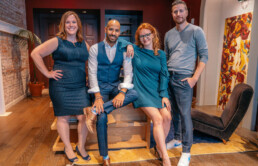3 Ways to Create Helpful Content That Google Rewards
3 WAYS TO CREATE
HELPFUL CONTENT
THAT GOOGLE REWARDS
DO'S AND DON'TS FOR BUILDING A PEOPLE-FIRST CONTENT STRATEGY
3 WAYS TO CREATE HELPFUL CONTENT THAT GOOGLE REWARDS
DO'S AND DON'TS FOR BUILDING A PEOPLE-FIRST CONTENT STRATEGY

With its new “helpful content update,” Google has officially drawn a line in the sand: If your brand prioritizes search results over supporting people, that approach is doomed to fail. But it’s a relatively small percentage of bad actors guilty of this. What does the new update mean for the vast majority of brands whose intentions are aligned with Google’s? Well, now there’s even more opportunity to stand out from the crowd with purposeful, customer-centric content rooted in strategy.
Here are some tips to help you seize the moment.
Let customer pains point the way
DO:
Voice of the customer research to get laser-focused on the pain points of your core personas. This evidence-based discovery takes the guesswork out of content creation and helps ensure you’re addressing what your audience cares most about.
DON'T:
Rely on “intelligence” from the content of others or anecdotal customer “insights” from your sales team. These can help support a more holistic research process, but in a vacuum they’re likely to result in the kind of shallow, copycat content that the algorithm now dings.
Unite everything with purpose
DO:
Be methodical about establishing your brand architecture, starting with a super clear vision (destination), mission (road map) and purpose (feeling that everyone, from the CEO to the summer intern, gets when you reach it). Google rewards a singular focus and consistent messaging, so let these statements serve as your North Star guiding all content creation.
DON'T:
Pursue ad hoc content outside your core area of expertise to capitalize on trending topics. While a one-off article might be helpful to some, if those people come to your website expecting more similar content as a result, that’s not helpful.
Embrace the audit
DO:
Regularly conduct holistic website audits that incorporate Google’s most up-to-date methodologies. If your site contains content deemed “unhelpful,” that will negatively impact the performance of all other content — even a “helpful” piece.
DON'T:
Allow content that’s out-of-date or irrelevant to your audience on any page of your website. It’s OK to have HR share responsibility for the “Careers” section, but ultimate oversight of all web content should be clearly delegated and actively enforced.
At Summer Friday, we’ve got the content strategy chops to help your brand boost conversions and connect with more customers.
Contact us at say@heysummerfriday.com if you’d like to have a no-strings-attached conversation to discuss how.
To defuse or to detonate
to defuse or to detonate:
HOW A CATASTROPHE CHANGED MY APPROACH TO LEADERSHIP AND LIFE

Rob Simone – President – Summer Friday
@robtsimone
rob.simone@heysummerfriday.com
“The real troubles in your life are apt to be things that never crossed your worried mind… the kind that blindsides you at 4pm on some idle Tuesday.”
— Mary Schmich, “Wear Sunscreen”
It was just that kind of Tuesday… April 14th, 2020.
The entire country — possibly the entire human race — was obsessed with how to operate during a pandemic. How to work from home. How to educate our children remotely. How to keep from, well, confronting our own mortality.
I had just spent two weeks working with my leadership team at DRUM — an independent, mid-size marketing agency — to enact a plan, effectively cutting costs while somehow realizing zero lapse in coverage and quality for our clients. Of course, the plan included furloughs, pay cuts, and the whole package. Sound familiar?
Surprisingly, we were on our way to getting things under wraps quite well when that “idle Tuesday” hit with all its might. I received a phone call from the owners of DRUM, informing me that the agency was being shut down. Not re-organized, not transitioned, not bought out. Shuttered. And it wasn’t a discussion; it was official notice.
As president of the agency, there was nothing I could do to stop it. I had the title but lacked a vote.

Shortly after that call, roughly 100 employees in three cities were terminated via email. Similarly, our clients were sent a terse letter of disengagement. Pin pulled, grenade tossed.
The promises I had made to team members about what we were building suddenly felt dirty. The trust they had placed in me, paired with my helplessness to change anything, made me feel weak. Employees with mortgages, babies on the way, even recent hires were all left in limbo. Clients had been abandoned mid-flight and carefully cultivated partnerships were at best questionable. And selfishly, I couldn’t help but think about my own reputation, equity, income, family. What was I going to tell my wife?
Then, out of nowhere, I remembered something: the classic 1994 Clancy/Noyce film, Clear and Present Danger. An unlikely memory for an even unlikelier time. Harrison Ford, as Jack Ryan, sat in the Oval Office, calmly telling a frantic president, “There’s no sense in defusing a bomb that’s already gone off.”

“Lifelong Friends scene,” Phillip Noyce, Clear And Present Danger, 1994
When I first watched that scene many years ago, the character’s advice struck me. But as I grew older and experienced ever more precarious business scenarios, I understood that we all have the impulse to try and reverse, re-engineer, maybe even remove things that have taken place that we wish hadn’t. We waste precious time lamenting the reasons and circumstances that caused such events to take place. Instead, Jack Ryan simply accepts what has taken place as finished, and instead searches for a path to convert the circumstances into something potent and powerful.
It’s no accident that I’ve always considered myself something of a “wartime president.” I don’t mean that in a martyrish or self-congratulatory way. It’s just that I find myself much more productive and poised during moments of chaos and difficulty than during stability. I thrive in the trenches and I work with others like this. In fact, while leading three different companies over the years, my greatest challenge was always in finding ways to add tangible value when operations and growth were running smoothly. Go figure.
With the doors of DRUM having slammed shut, the bomb had already detonated. There was nothing left to defuse — literally, nothing left to lose. With that realization, I found the power I needed and began to get excited. And it was quite simple:
“When the universe rips off the band-aid for you, there’s a whole lot less to fear”

Think about all of the times you planned a new project, even a new business. Or the startup you fantasized about joining, but required a pay cut. Or that screenplay you wanted to write. Most of us have a list of scenarios like these that are a little less than rational. It’s one thing to take these risks in our 20s, when we have little to lose financially, not to mention boundless energy and the capacity to put in hundred-hour weeks without interruption. Cut a few decades later, with a marriage, a mortgage, three kids — and the stakes of the game have changed. I’m only slightly ashamed to admit that the circumstances would have had to have been literally ideal for me to take the career risks that I dreamed of. But when the universe kicked me squarely in the seat of the pants, I pouted for a day. And then I got to work.
The one thing that I couldn’t quite shake was the legacy partnerships. When I looked back at what had been built at DRUM — and even before — it was clear that we had assembled some productive, powerful, symbiotic relationships with clients. One such relationship with a major investing brand had endured for over 14 years and through almost every challenge an account can have. That’s why I came to the conclusion those partnerships were well worth trying to preserve, as were the talented team members that had trusted us and worked alongside us.
With the right planning, maybe we could create a new company designed around those shining partnerships, effectively reverse-engineering a boutique agency with success cases as the control group. As an approach, it was almost naive.
Thankfully, my naivete was reinforced by another partner, my CFO and indispensable left-brain ally, Sarah Roberts, who replied to my first call with a resounding, “I’m in!” We both knew that we had a good shot at securing enough foundational revenue to get a ground-floor team engaged and focused. The key, however, was removing the burden of infinite growth from the vision.
DRUM, like many marketing agencies, had been conceived by its founders to grow to the point that it would make an attractive acquisition for one of the big holding companies to slurp up. It had a ways to go yet, but that was the goal. Looking back, I can’t fault them. Its founders had done it before, and conventional wisdom suggested they ought to do it one more time before retirement. When that vision became blurry, they cut bait.
Though the early pandemic timing was unusual, the story isn’t. Many agency owners have been strapping themselves to aggressive year-over-year growth as their sole success metric, while counting on a big exit down the road as their primary means of achieving wealth. But our industry was changing and, with it, client tenure was waning and margins were shrinking. The entire modern marketing model now requires deeper technical expertise and hard costs galore — which, in turn, creates a treadmill effect for small and mid-size agencies: It’s a never-ending cycle of chasing new business, recruiting new talent to serve those clients, over-expanding, downsizing, cost-cutting, and eventually starting the cycle all over again.
“After two journeys down this road I wasn't prepared to do it again...”
Here’s why: When your company is beholden to any form of an external financial body or decision-making committee, it’s simply not possible for you to maintain control. And it’s impossible to treat your team like the assets they are.

Antonio Lopez, is a lifelong friend of mine, is a leading talent management consultant who specializes in building purpose-driven leadership teams. As we talked in 2020, he broke down the process of cost accounting and the way labor is traditionally treated. Naturally, I had seen plenty of P&L statements over the years, but it never really sunk in. Employees, talent and people are listed as “liabilities” on balance sheets. And unfortunately, this isn’t some accident of nomenclature. Most companies actually treat their people as exactly that: a hindrance. A handicap. An unfortunate obligation.
It’s a corporate cliche by this point: CEOs stand up at town hall meetings and refer to talent as their greatest asset. But then when the numbers don’t add up for a quarter, they throw their assets to the curb. They don’t throw out computers or company cars. They lay people off. And many of these same companies maintain expensive retention and education programs, which means they spend hours and dollars improving the quality of their assets only to shed them. A few months later, they’re back to recruiting, training and retaining. And the cycle continues.
This trend is fueled by the constant expansion and shrinking of revenue. And the ultimate goal? Growth. Bigger. More. To infinity and beyond. Why this obsession with growth? Because most companies are beholden to external financial overlords or governing bodies. Inactive owners want equity. Shareholders want price performance. Investors want big exits.
But if infinite growth isn’t your key KPI, you’re free to focus on something else: stability and sustainability. And, believe me, your clients can feel the difference. To wit: At DRUM, I was always inclined to find ways to force a fit between our team and an assignment. Why? Because we needed the revenue to meet our growth goal. And because, as head of business development, my compensation was tied in part to “new revenue.” And because we believed that there would be some eventual end to the Sisyphean effort of chasing projects.
I learned that, yes, it is possible to win clients that turn into wonderful partners. And we did some exceptional work. But I also learned that, when revenue is your primary motivation for making a decision, your supporting team can lack passion. We should have known better.
Now, we have removed revenue as the primary motivator, instead empowering our team to decide if they want to commit to a client. By doing so, we extend trust and freedom to the very individuals who will be on the front lines of our valued relationships.
I believe it’s possible to build something much better for everyone using this model. It takes intention and determination early on. In our first six months, I unveiled this plan to my partners and was thrilled when we all shared a passion for this direction.
We agreed that there were some very impressive, large company cultures out there — companies that had grown to an enviable scale and had managed to maintain their fundamental positive characteristics. But we also agreed that they are few and far between. And that “big” wasn’t best for us.
Our goal was clear: We wanted to grow a solid, nimble boutique. Refreshing and clear. But in order for me to get it right this time, I had to make a choice that can be challenging for many leaders — a choice that the owners of our last endeavor had failed to make. In the early days of Summer Friday, I chose to fully trust my partners to lead their domains their own way. To let go of senseless control and insecurity that comes with the pressure to succeed.
With this model in place, and our sights firmly set on alternative performance metrics, it was time to think about culture. I can admit now that I was largely in denial about how toxic agency culture had become at DRUM. At the time, I was under the impression that good intentions, paired with the work I was doing as president, could outweigh the legacy conventions that were being reinforced by several key players. And in retrospect, it’s likely that some of that toxicity was so hardwired into the culture, nothing could wash it clean.
That’s not to say it wasn’t worth saving. Quite the contrary, in fact. I’m indebted to those who filled my sail with wind during the darkest times. Many of my colleagues at DRUM gave it their sincere, devoted, best effort — and I am still humbled by that to this day. And it’s all the more reason our renewed opportunity with Summer Friday absolutely requires paying homage to those talented individuals and devoted clients who made its birth possible.
Focusing on culture requires us to be uncomfortably honest and fearless.

If you look at your own life, you’ll likely find that your longest-lasting, most fulfilling relationships are bound by vulnerability and honesty. That principle translates to the professional world much more directly than we often believe.
Corporate America has taught us to posture, spin, and dissemble our way through business. We learned we shouldn’t speak up when we lack resources or don’t know the answer, because that somehow makes us seem weak. That we will be judged. When traits like this get reinforced over time within a culture, they can become a toxic thread in the organizational fabric. And while they can sometimes promote short-term performance, they are a long-term disaster — and primary contributors to turnover and errors.
From day one, my partner, Michael Cruz, head of content at Summer Friday, focused on building a culture of empathy and emotional intelligence. He asked for my alignment in allowing him to build the dream creative department that he had conceived — one free of limitations and legacy restrictions. Guess what? He did it. And I am awestruck to this day.
At DRUM, I had watched Alicia Wiedemann run an account services department that was consistently forced to fight with one hand tied behind its back. And because she was forced to play defense, her entire role was focused on fixing problems and “saving accounts.” As a result, people piled impossible tasks on her desk. They questioned her leadership and qualifications. But I saw a fighter. Someone who kept going to battle, no matter the lack of resources, support or credit.
Instead of “saving accounts,” she was learning to craft strategies under impossible pressure. The only thing she was missing was the trust and authority to blaze her own trail. So, we asked her to be a partner and head our client strategy department. Unsurprisingly, some of her best strategists raced to follow.
Together, Sarah, Michael, Alicia, and I decided that our job as leaders was to root out toxicity early and often. To do so, we needed to focus on our unique value proposition (UVP) as the epicenter of organizational tone.

Consider every single UVP you have heard. They are almost universally constructed to extend from the company to the client or customer. Many speak directly and convincingly to the target audience. At Summer Friday, we made the unorthodox decision to realign our UVP to focus on our team — not our clients. As a business development professional, it feels criminal to say. But in practice, it’s beneficial to both our clients and our team. And it’s astonishing to me that this approach is so rare. Because, when you focus first on your people, the benefits directly transfer to your clients in a very concrete way. You can’t do it halfway. And you can’t fake it.
At Summer Friday, “Culture Above All” is the crux of our UVP. We take several actions to support it:
We take an individualized, holistic approach to wellness, equipping our employees to be happy, healthy and passionate.
We choose to work only with clients and on assignments that are an ideal fit from the standpoint of skills and chemistry. As a result, we can do less — and do it better.
We are a deliberately “right-sized” boutique, with 30 to 50 employees partnering with 10 to 15 clients. This allows us to remove infinite growth from our crosshairs while promoting strength and sustainability in all decisions.
These three concepts are designed to reduce toxicity, promote deep collaboration, and achieve a passionate work/life balance. Is it perfect? No. We remain students of our company and seek to challenge conventional wisdom. Along the way, we’re fully aware that we are a young company and we rely on humility as often as possible to check our progress.
Challenging conventional wisdom doesn’t require you to always be radical. It simply requires you to be open to the alternative and to question your own playbook. In our first year, we learned that having the courage to try something unorthodox generally pays off. More importantly, we were emboldened by the fact that when it didn’t, honesty allowed us to reform and improve the policy. Nobody within the leadership — or among the broader team — claims to have it all solved.
There’s a well-known concept attributed to the Israeli Intelligence community called the “Tenth Man Rule.” Quite simply, it designates a devil’s advocate among groups of people who are responsible for making important policy decisions. I remember hearing about this concept in the popular 2013 Marc Forster film, World War Z, later learning how fundamentally powerful this practice can be within professional groups or committees. We all know how difficult it is to go against the grain and speak up with a contrarian opinion in a corporate setting. All too often, consensus can occur out of fear. The Tenth Man Rule removes the stigma from the naysayer and designates an alternative approach as standard practice.
While we aren’t using this approach to solve issues of national security, we have hacked it quite effectively to produce some of our most prized attributes and policies. In fact, our appetite to challenge conventional wisdom has affected nearly every facet of Summer Friday — and the compounding result is staggering.
For example, when we first built the company’s suite of benefits, we implemented unlimited vacation days for our team. Why? Because we decided to not be afraid of what would happen if our people abused this policy. Similarly, when we had our first all-hands town hall meeting, we decided to be extremely transparent with the company’s financial performance and objectives — something that I had never seen take place at past agencies. When dealing with a team member who didn’t quite fit into a clear org chart trajectory, we allowed her to craft a custom role that touched several departments and skill sets. Freedom to think differently and experiment became the essence of our leadership approach. And because we had spent so much time onboarding talent that we truly respected and were invested in, we trusted them to deal well with the liberty they were extended. And they do.
Above all, we learned that when you build a strong company culture — one that is based on shared values and trust — the worst parts of doing business become so much easier. Team members who aren’t the right fit tend to work themselves out in a mutually understood fashion. And not being the right fit isn’t shameful or even contentious. In other words, it’s not a judgment that Summer Friday is making about an individual being less than exemplary; rather, it’s a shared recognition that chemistry is lacking, and a desire to move forward with mutual goodwill. The conversations become easier, more supportive and free of resentment. And because the culture is strong, open and confident, team members support and honor transitions with an optimistic nod to the future.
Our beautiful experiment is now two years in the making. And I am thrilled to say that we are thriving. We feel a sense of widespread satisfaction among both our clients and team. But more importantly, we feel a strong sense of pride in what we have built. It’s an important dynamic to acknowledge: I have been proud of many endeavors in my career. But in Summer Friday, we have built a company composed of individuals who feel a connection and sense of ownership, regardless of seniority.
When I think back to that fateful Tuesday in 2020, it is almost painful to think of having made a different decision. Since then, I have embraced the tools and dynamics that define the type of leadership I want to represent. And while I’m inclined to take credit for some of the success, I know that the true impetus for doing good work was a calling from the universe. It was more than a kick in the ass; it was a gift. And by choosing to not defuse a bomb that had already gone off, my team, my partners and I took a risk that redefined our lives.
President
A lifelong veteran in the content innovation space, Rob co-founded the groundbreaking boutique Hiccup Media in 2006 with creative partner Michael Cruz. After 14 years of scaling and expanding the business, Rob continues to focus his abilities on assembling key talent and growing successful creative companies. As President of Summer Friday, he’s devoted to building sustainable, trust-based partnerships with leading brands.
Why is Leadership Important in Business?
“When leaders consistently demonstrate humility and positive vulnerability, it reverberates through a culture and creates a safe, trust-based environment–—one where employees feel more independent, loyal and satisfied. And this translates to happier clients and better bottom line results.” Read more of Summer Friday President Rob Simone’s thoughts on leadership in this recent article from UpJourney: https://upjourney.com/why-is-leadership-important-in-business
Finding the Right Marketing Team
We believe every brand should be able to articulate its unique value proposition in just a few words, not a few paragraphs. Summer Friday’s? Culture above all. Hear our President Rob Simone talk about that and more on Nick Westergaard’s On Brand podcast: Listen
You don’t need another agency. You need a strategic partner. UK
It’s all about building
a strategic foundation
We start by looking at your unique short and long-term needs and co-create a plan of action – bringing in our strategy and creative teams who can make it all happen – right from the start.
Brand Development & Refresh
Go-to-Market Strategy & Execution
Content Optimization & Refinement
From tech challengers to financial powerhouses, our clients are as varied as their needs.
You don’t need another agency. You need a strategic partner.
It’s all about building
a strategic foundation
Our nimble approach allows us to balance big-picture strategic initiatives with immediate priorities. We start by looking at your unique short- and long-term needs, then we develop a brand identity and communications plan to fit those needs — with a creative team who can make it all happen.
Brand Development & Refresh
Go-to-Market Strategy
Content Optimization & Refinement
Media Strategy
Seeing is believing
These are a few of the early-stage companies we’ve helped bring to life.
Shifting to customer centricity: Three challenges financial service brands face
If there’s one thing we’ve learned in 2020, it’s that customer centricity equals relevancy — and financial services are no exception. Customers have increasingly high expectations for what the digital landscape can provide, and there’s no shortage of competitors vying for attention with flashy new capabilities and content. For financial services, a major shift from product centricity to customer centricity is imperative to keep up with the times, but it’s easier said than done.
At Summer Friday, we’ve seen financial service brands face three main challenges as they shift gears to a more customer-centric approach:
1. Data collection
Many financial institutions are working to bring their manual customer data collection methods into the digital age. Large, established brands have the furthest to go, with traditional business silos and legacy technologies that lend themselves to outdated and incomplete data.
But the heavy lifting is worth the payoff. From now on, content will constantly be tailored to customers based on traditional criteria, like which stage of the buying journey they’re in. But it will also be based on much more nuanced data, like time of day, customer location, and the customer’s recent social media engagement. Seamless multichannel communications and the ability to effectively and consistently manage customer data become critical to keep up with this demand.
And procuring the data is only the first step. At Summer Friday, we harness that data to make connections and find insights that improve engagement and conversion.
2. Quality content at scale
While data collection is its own challenge, there’s a second hurdle to overcome — shifting to a publisher model and creating quality content at scale. Brands already need engaging, high-quality content. Now, they also need that content to add value and build relationships with customers using targeted, audience-specific calls to action at each stage of the customer journey.
At Summer Friday, we understand this is no small task. Targeting customers throughout their brand experience necessitates a robust and segmented content calendar. Without the right content partner, this undertaking quickly becomes cumbersome and difficult to sustain.
We have a few guiding principles that keep us on track while producing content at scale:
Surrender your ego. Your audience knows what they like and don’t like. Your content is there to serve them.
Consider the back button. The back button defines what is and isn’t seen, so create something that makes its use impossible.
Behave like the guest you’d want to host. Practice good digital manners and be open and honest with your intentions.
3. Culture
Another challenge brands face while shifting to customer centricity is implementing a cultural adjustment. It’s not easy to evolve a brand of any size from the mindset of “How can we sell products?” to a mentality of “What does the customer really want, and how can we provide it?” But this commitment is just as crucial as streamlining data collection if you want your business to be customer-centric and competitive in the current digital landscape.
With how quickly things can change, staying relevant and culturally involved is a 24-hour operation. Summer Friday approaches this challenge with a publisher mindset and “always on” content studio. We understand that even the most meticulously planned content calendars must leave room to evolve with what’s happening in real time, and we’ve done just that for many brands, including our work with TradeStation.
Reach out and we’d love to talk more about what your brand can do to begin or continue your journey toward customer centricity.
Shifting to customer centricity: Three challenges brands face
If there’s one thing we’ve learned in 2020, it’s that customer centricity equals relevancy. Customers have increasingly high expectations for what the digital landscape can provide, and there’s no shortage of competitors vying for attention with flashy new capabilities and content. A major shift from product centricity to customer centricity is imperative to keep up with the times, but it’s easier said than done.
At Summer Friday, we’ve seen brands face three main challenges as they shift gears to a more customer-centric approach:
1. Data collection
Many institutions are working to bring their manual customer data collection methods into the digital age. Large, established brands have the furthest to go, with traditional business silos and legacy technologies that lend themselves to outdated and incomplete data.
But the heavy lifting is worth the payoff. From now on, content will constantly be tailored to customers based on traditional criteria, like which stage of the buying journey they’re in. But it will also be based on much more nuanced data, like time of day, customer location, and the customer’s recent social media engagement. Seamless multichannel communications and the ability to effectively and consistently manage customer data become critical to keep up with this demand.
And procuring the data is only the first step. At Summer Friday, we harness that data to make connections and find insights that improve engagement and conversion.
2. Quality content at scale
While data collection is its own challenge, there’s a second hurdle to overcome — shifting to a publisher model and creating quality content at scale. Brands already need engaging, high-quality content. Now, they also need that content to add value and build relationships with customers using targeted, audience-specific calls to action at each stage of the customer journey.
At Summer Friday, we understand this is no small task. Targeting customers throughout their brand experience necessitates a robust and segmented content calendar. Without the right content partner, this undertaking quickly becomes cumbersome and difficult to sustain.
We have a few guiding principles that keep us on track while producing content at scale:
Surrender your ego. Your audience knows what they like and don’t like. Your content is there to serve them.
Consider the back button. The back button defines what is and isn’t seen, so create something that makes its use impossible.
Behave like the guest you’d want to host. Practice good digital manners and be open and honest with your intentions.
3. Culture
Another challenge brands face while shifting to customer centricity is implementing a cultural adjustment. It’s not easy to evolve a brand of any size from the mindset of “How can we sell products?” to a mentality of “What does the customer really want, and how can we provide it?” But this commitment is just as crucial as streamlining data collection if you want your business to be customer-centric and competitive in the current digital landscape.
With how quickly things can change, staying relevant and culturally involved is a 24-hour operation. Summer Friday approaches this challenge with a publisher mindset and “always on” content studio. We understand that even the most meticulously planned content calendars must leave room to evolve with what’s happening in real time, and we’ve done just that for many brands, including our work with TradeStation.
Reach out and we’d love to talk more about what your brand can do to begin or continue your journey toward customer centricity.
How personalized should your content be? 2
HOW
PERSONALIZED
SHOULD YOUR CONTENT BE?
You can’t attend a marketing webinar without hearing “personalization” 50 times in the first minute. And it’s no wonder — personalization has proven to be extremely effective, with up to a 6X higher conversion rate and a 19% uplift in sales. But while the world struggles to engage their target audience on a one-to-one level, sometimes the solution can be much simpler.
So when does it make sense to go all in on personalization, and what are your alternatives? At Summer Friday, we’ve produced content across the spectrum of personalization and we can make a recommendation that’s right for your audience, your objective, and your budget. Here are three approaches for content personalization we’ve used in the past:
1. Versioned Content
Versioned content is the first step toward personalization. It takes into account that your entire audience isn’t looking for the exact same thing, so it targets broad customer segments with slightly varied visuals and/or messaging vs. one mass piece of content that goes to everyone.
2. Segmented Content
Taking personalization a step further, segmented content goes deeper into the demographic nuances of your audience and serves them content that is directly relevant to them, personally. Modular videos fit into this category -- a number of scenes are created and customers see a video that includes only the modules (or scenes) that are specifically applicable to them.
2. Segmented Content
Taking personalization a step further, segmented content goes deeper into the demographic nuances of your audience and serves them content that is directly relevant to them, personally. Modular videos fit into this category -- a number of scenes are created and customers see a video that includes only the modules (or scenes) that are specifically applicable to them.
Full 1:1 Personalization
Fully personalized content speaks directly to each individual customer. For example, details like the customer’s name, account number, or when their next bill is due can all be included in a fully personalized video. These elements can even be updated in real time, so that personal details will refresh if a customer watches the same video again later.




























